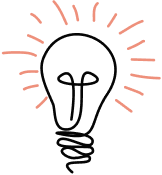In college, I had the opportunity to meet and listen to Jay Doblin, a world-renowned industrial designer who went on to found the Doblin innovation consultancy. At the time, Jay was professor emeritus at the Institute of Design at Illinois Institute of Technology.
He gave a brief talk, walking through part of a paper he wrote in 1978, called “Innovation: A Cookbook Approach.” In it, he lists over a dozen different “mental ‘loosening up’ processes” that designers can use to help them build better products. His suggestions range from “think like the product” (referencing how Einstein used to imagine himself as a ray of light before landing on the formula E = mc²) to hailing the benefits of the relatively new concept called brainstorming.
One of the processes he mentioned that really stuck with me is the “Seven Levels of Design.” He writes that “changing levels can give designers an opportunity to innovate,” using a thought experiment of a problem and varying degrees of solutions. This framework never lost its relevance to my work in software development and design.
I think the Seven Levels of Design is a great process that developers, designers, and engineers at any level can use to challenge themselves and expand their thinking. You can use this post as a primer to wrap your head around the process, and then apply it to a problem you’re currently facing, or use it with your team to get their creative and critical thinking skills flowing.
So, I present here, the Seven Levels of Design by Jay Doblin (as best I can recall). The framework for the process is this:
- The designer or design team is given a problem.
- The designer/team is encouraged to think through the problem at seven continually expanding levels.
- As the levels increase, the scope of the problem (and approach to solutions) expands for more clarity and provides more insights. The higher up in the levels of design you go, the more you widen your perspective on the problem. The more you widen your perspective on the problem, the more radical your solutions become.
The goal of the thought experiment is not necessarily about getting from one level to another. It’s about helping you see problems (and their potential solutions) from different viewpoints.
The best way to understand the Seven Levels of Design is to see it in action.
Let’s start with this problem:
”When I go outside, I get wet when it rains.”
How might we solve this problem?
Level 1: Wear a rain suit. A decent solution, but we’re dependent on weather forecasts and a rain suit is encumbering. Perhaps an umbrella which is portable, but usually pants and shoes get wet and if it’s windy.
Level 2: Wear hydrophobic clothing. Performance is improved on a wearable garment.
Level 3: Use an automated umbrella or a device which dries out the user as rain is encountered.
Levels 1–3 are changes to the basic mechanism of repelling precipitation.
Up to this point, the solutions are augmentative in nature. The simple solutions have improved capabilities and provide additional conveniences. And really, these solutions are addressing part of the problem (personally getting wet when it rains). However, in some cases, new problems are created.
Let’s keep moving…
Level 4: Build covered walkways or shelters. Minneapolis’s Skyway not only keeps people dry as they walk from building to building but keeps them warm in the winter and reduces pedestrian traffic at intersections.
Level 5: Build a dome over the public space or city. A little too sci-fi or unrealistic for now, but now an entire city can control precipitation. While the covered walkway solution is scaled up, so too is the impact.
Level 6: Weather control. It rains when we want it and not when we’re out and about. Again, likely unrealistic given the current nature of climate change.
These solutions are transformative — they change the problem space and new solutions are synthesized. These solutions address the problem more fully. In this example, the designer is encouraged to reexamine what it means to “go outside.” The lower level solutions look at the problem of getting wet when it's raining. Expanding the problem space — exploring how to manage the outdoor climate — opens up new thoughts to the problem.
So then what's next?
Level 7: The problem is eliminated with telecommunications — there’s no need for walking outdoors (unless you want to) as all human contact and services are provided via web/internet. In some cases, this is becoming reality — no need to go outside when it’s raining to go to the bank or get groceries or buy a new pair of shoes. All of this can be done online.
By Level 7, the solution transcends the problem — not by ignoring it, but by seeing beyond the problem definition or eliminating the need. If we don’t go outside, we can’t get rained on. How might we reduce the necessity to venture out into the elements?
If I were to simplify this down to a few categories, I’d suggest we have 3 kinds of solutions to a given problem:
- Augmentation — improving function to address a problem
- Transformation — changing the problem
- Transcendence — eliminating the problem
Simplification might help with understanding, but I like the way Jay lays out the thought experiment. It guides us through examples of how we might think about the problem or need and varying ways to address or solve the issue. Seeing the problem in a new light by understanding it thoroughly and clearly allows developers, designers, and engineers — all synthesists — enables us to change the problem space or eliminate it altogether.
Jay’s original “7 Levels” thought experiment demonstrates different ways to solve the problem of fueling cars — it traverses from better fuel economy to different fuels (like electricity or atomic) to eliminating the need for travel altogether through telecommunication. At the end of his original experiment, Jay remarks:
Most design problems are solved at level 1; a few are at level 2. A designer may get one level 3 job in a lifetime. Picture the look on a client’s face if after assigning a designer the task of redesigning a gas pump, he is told that the solution is telecommunication. This example, which may seem ridiculous, is a real problem.
Similarly, so much of what we do in software solutions happens at Levels 1 and 2. While many software solutions automate and attempt to make information access easier, consumable and efficient, not much is addressed concerning the original problem of needing the information in the first place.
For example, we can develop really nice apps that help manage diabetes, but the real solution, which may be either technical or socio-cultural in nature, is eliminating diabetes. If we wanted to eliminate the personal and societal cost of auto insurance, we could introduce self-driving vehicles, teleportation, or eliminate the need (but not necessarily the desire) for travel altogether.
Innovation can happen at all these levels — augmenting or enhancing products happens with increasing frequency. Big things happen when we transform and transcend problems in search of new solutions. And sometimes, if you don’t stop and take a look around, you might not notice the change. I just hope one day you’re reading this in your self-driving car.



